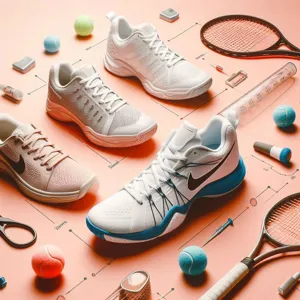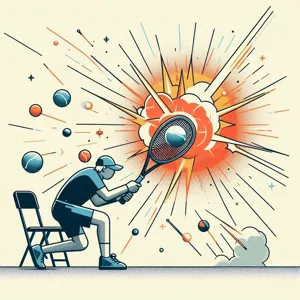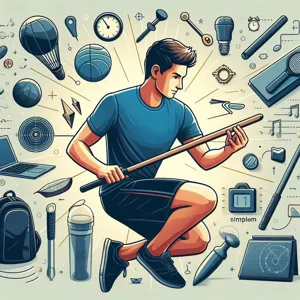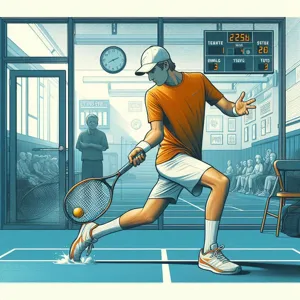Whether you’re a seasoned pro or just picking up a racquet, tennis is a sport that demands agility, strength, and endurance.
However, to truly excel on the court, maintaining flexibility and preventing injuries is just as crucial as perfecting your serve or backhand. Enter the power of stretching! Incorporating a dedicated stretching routine into your training regimen can significantly enhance your performance, allowing you to move more freely and react faster to every volley and rally. In this blog post, we’ll explore the top 10 essential stretches that every tennis player should embrace to unlock their full potential. From dynamic warm-ups that prepare your muscles for action to deeper static stretches that promote recovery and flexibility, these exercises will not only help you play your best but also ensure you stay in the game longer. So grab your mat, and let’s get ready to stretch our way to peak performance on the tennis court!
1. Introduction to the Importance of Stretching in Tennis

Tennis is a dynamic sport that demands a unique blend of strength, agility, and endurance. As players move swiftly across the court, executing powerful serves and rapid volleys, their bodies experience a tremendous range of motion and strain. This is where the significance of stretching comes into play. Incorporating a well-structured stretching routine not only enhances performance but also serves as a crucial preventive measure against injuries.
Stretching prepares the muscles for the explosive movements required in tennis by increasing flexibility and promoting blood flow. When muscles are pliable, players can achieve greater reach and execute strokes with increased power and precision. Furthermore, regular stretching helps to alleviate muscle tightness, which can lead to discomfort or even injury if left unchecked. By dedicating time to stretch before and after matches, players can ensure their muscles are primed for action and recover efficiently afterward.
In addition to physical benefits, stretching also fosters mental readiness. Taking a few moments to focus on breathing and body awareness can help players enter the right mindset for competition, enhancing concentration and reducing anxiety. With this in mind, let’s explore the top 10 essential stretches that every tennis player should incorporate into their routine to achieve peak performance and enjoy the game to its fullest.
2. Benefits of Stretching for Tennis Players
Stretching is an often-overlooked component of a tennis player’s training regimen, yet its benefits are profound and multifaceted. Engaging in a dedicated stretching routine offers a wealth of advantages that can significantly enhance performance on the court.
Firstly, stretching improves flexibility, allowing players to reach for those challenging shots that might otherwise be out of reach. This increased range of motion can make a notable difference in a player’s ability to execute powerful serves, dynamic volleys, and precise groundstrokes. Additionally, flexibility helps in maintaining proper technique, reducing the risk of injury that can arise from tight muscles and joints.
Moreover, regular stretching enhances blood flow to the muscles, which is crucial for optimal performance. Improved circulation means that muscles receive more oxygen and nutrients, enabling them to work more efficiently during play. This can lead to increased endurance, allowing players to maintain their energy levels throughout long matches, especially during grueling tournaments where stamina is key.
Stretching also plays a vital role in injury prevention. Tennis involves repetitive movements that can strain muscles and joints; incorporating stretching into your routine can help to alleviate tension and reduce the likelihood of common injuries such as strains, sprains, and tendonitis. By keeping muscles pliable and joints mobile, players can enjoy the game they love with less downtime due to injury.
Finally, stretching contributes to mental well-being and focus. Taking the time to engage in deep, intentional stretching allows players to center themselves, enhance their concentration, and relieve stress. This mental clarity can be invaluable during intense matches, where staying calm and composed can make all the difference.
In summary, the benefits of stretching for tennis players are undeniable. From improved flexibility and blood flow to enhanced injury prevention and mental focus, incorporating a regular stretching routine is essential for any player looking to achieve peak performance on the court.
3. Stretching Safety Tips: Do’s and Don’ts

Stretching is a crucial component of any tennis player’s training regimen, but it’s important to approach it with caution and awareness. To help you maximize your flexibility while minimizing the risk of injury, here are some essential do’s and don’ts to keep in mind when incorporating stretches into your routine.
**Do’s:**
1. **Warm Up First**: Always begin your stretching session with a light warm-up to increase blood flow to your muscles. Spend 5 to 10 minutes engaging in light cardio—like jogging or cycling—to prepare your body for deeper stretches.
2. **Listen to Your Body**: Pay attention to how your body feels during each stretch. If you experience sharp pain or discomfort, ease off. Stretching should create a gentle pull in the muscle, not a painful sensation.
3. **Hold, Don’t Bounce**: When performing static stretches, hold each position for 15 to 30 seconds without bouncing. Bouncing can lead to muscle strain and doesn’t effectively elongate the muscle fibers.
4. **Focus on Major Muscle Groups**: Prioritize stretching the key muscle groups used in tennis, such as your hamstrings, quadriceps, shoulders, and back. This targeted approach will enhance your performance on the court.
5. **Stay Hydrated**: Proper hydration is essential for muscle function and flexibility. Drink plenty of water before and after stretching to keep your muscles pliable.
**Don’ts:**
1. **Avoid Stretched Beyond Comfort**: Don’t force your body into a stretch. Pushing too hard can lead to injuries such as strains or tears. Always respect your body’s limits.
2. **Don’t Rush Through Stretches**: Take your time with each stretch. Rushing can prevent your muscles from fully relaxing, which reduces the effectiveness of the stretch and increases the risk of injury.
3. **Skip Post-Match Stretching**: Many players overlook the importance of stretching after matches or practice sessions. Post-exercise stretches can help alleviate muscle tightness and facilitate recovery, so make it a non-negotiable part of your routine.
4. **Neglect Consistency**: Stretching should be a regular part of your training, not a last-minute addition. Consistency will yield the best results, improving your flexibility and overall performance.
5. **Ignore Professional Guidance**: If you’re unsure about proper stretching techniques, don’t hesitate to consult a coach or physical therapist. They can provide personalized guidance and help you develop a routine tailored to your specific needs.
By following these do’s and don’ts, you’ll be well on your way to achieving optimal flexibility, reducing the risk of injury, and enhancing your performance on the tennis court. Remember, effective stretching is not just about reaching your toes—it’s about fostering a sustainable practice that supports your athletic journey.
4. Warm-Up vs. Cool Down: Why Both Matter
When it comes to maximizing performance on the tennis court, the importance of both warm-ups and cool-downs cannot be overstated. Each serves a distinct purpose in preparing the body for the rigors of the game and aiding in recovery afterward.
**Warm-Up: Preparing for Action**
Before you step onto the court, a proper warm-up is your first line of defense against injury and a crucial component of your performance. Think of it as the ignition for your body’s engine. Engaging in dynamic stretches, such as arm circles, leg swings, and torso twists, helps to increase blood flow to the muscles, raising your core temperature and making them more pliable. This gradual increase in activity not only enhances your range of motion but also primes your nervous system for the quick, explosive movements that tennis demands. A few minutes of brisk jogging or skipping can also elevate your heart rate, ensuring that your body is fully ready to respond to the demands of the game.
**Cool Down: The Path to Recovery**
On the other hand, the cool-down is often overlooked but is just as vital for peak performance. After an intense match, your muscles are fatigued and may be prone to soreness. Engaging in static stretches such as hamstring stretches, quadriceps pulls, and shoulder stretches helps to gradually lower your heart rate and prevent muscle stiffness. These stretches, held for 15-30 seconds each, promote flexibility and aid in the recovery process by encouraging blood flow to the muscles, which can help to flush out lactic acid buildup and reduce soreness.
In summary, both warm-ups and cool-downs play critical roles in a tennis player’s routine. A comprehensive warm-up prepares your body for action, while a thoughtful cool-down aids in recovery and prepares you for your next match. By integrating both into your training regimen, you set the stage for improved performance and longevity in the sport you love.
5. Stretch 1: Standing Quad Stretch

The **Standing Quad Stretch** is a fundamental stretch that every tennis player should incorporate into their routine to maintain peak performance on the court. This stretch targets the quadriceps, a group of muscles located at the front of your thighs that are crucial for powerful leg movements, sprinting, and explosive serves. Tight quads can lead to reduced mobility and an increased risk of injury, making this stretch essential for any serious player.
To perform the Standing Quad Stretch, find a stable surface for balance, such as a wall or the back of a bench. Begin by standing tall with your feet hip-width apart. Gently bend your right knee and bring your heel toward your glutes. Grasp your right ankle with your right hand, pulling it gently closer to your body. Be sure to keep your knees together and your hips pushed slightly forward to maximize the stretch. Hold this position for 15-30 seconds, feeling the stretch along the front of your thigh. Switch sides and repeat.
Not only does this stretch enhance flexibility, but it also helps to prepare your body for the explosive movements and quick direction changes that are integral to tennis. Regularly incorporating the Standing Quad Stretch into your warm-up routine can lead to improved performance, greater endurance during long matches, and a decreased likelihood of muscle strains. Remember, a well-stretched quad can mean the difference between a powerful serve and a missed opportunity!
6. Stretch 2: Seated Hamstring Stretch
### 6. Stretch 2: Seated Hamstring Stretch
The Seated Hamstring Stretch is a fundamental exercise that every tennis player should incorporate into their routine, as it targets the often-neglected muscles along the back of the thighs. Tight hamstrings can lead to reduced mobility and an increased risk of injury, making this stretch essential for maintaining peak performance on the court.
To perform the Seated Hamstring Stretch, find a comfortable spot on the floor or a mat and sit with your legs extended straight in front of you. Keep your back straight and engage your core to maintain good posture. Slowly reach forward towards your toes, allowing your torso to hinge at the hips rather than rounding your back. You may not reach your toes right away, and that’s perfectly fine; the goal is to feel a gentle stretching sensation in the back of your legs without straining.
Hold this position for 20 to 30 seconds, breathing deeply and allowing your body to relax into the stretch. As you hold the stretch, visualize the tension melting away from your hamstrings, which will not only improve your flexibility but also enhance your overall range of motion. For an added benefit, you can alternate between reaching for your right and left toes, which will help to stretch each hamstring individually and promote balance in your flexibility.
Incorporating the Seated Hamstring Stretch into your pre- and post-match routines can significantly improve your agility and explosiveness on the court. By prioritizing this stretch, you are investing in your longevity as a player, ensuring that you can perform at your best while minimizing the risk of injuries that could sideline you for weeks.
7. Stretch 3: Lunging Hip Flexor Stretch

The Lunging Hip Flexor Stretch is a vital exercise for tennis players looking to enhance their performance and prevent injuries. This stretch targets the hip flexors, which play a crucial role in your ability to sprint, pivot, and generate power during those intense rallies on the court.
To perform the Lunging Hip Flexor Stretch, start by kneeling on your right knee, ensuring your left foot is positioned flat on the ground in front of you, forming a 90-degree angle at your knee. As you maintain your balance, gently push your hips forward while keeping your back straight. You’ll feel a deep stretch in the front of your hip and thigh on the kneeling leg. To intensify the stretch, raise your right arm overhead and lean slightly to the left, creating a beautiful opening through the entire hip and side.
Hold this position for 20-30 seconds, breathing deeply to help your muscles relax. Switch sides and repeat the stretch on your left leg. Incorporating this stretch into your routine not only increases flexibility but also helps alleviate tension in the hip area, which can accumulate from the repetitive motions of tennis. Regularly practicing the Lunging Hip Flexor Stretch will enhance your mobility, enabling you to move swiftly across the court while reducing the risk of strains and injuries. Remember, a well-prepared body is key to excelling in every match!
8. Stretch 4: Standing Calf Stretch
The Standing Calf Stretch is an essential addition to any tennis player’s warm-up and cool-down routine, targeting the often-overlooked muscles in the lower legs. These muscles play a crucial role in your overall performance on the court, providing the explosive power needed for quick sprints, sharp pivots, and powerful serves.
To perform this stretch effectively, begin by standing tall with your feet hip-width apart. Step one foot back, keeping it straight while bending your front knee. Ensure that both heels remain planted on the ground as you lean forward slightly, feeling the stretch deepen in your back calf. Hold this position for 15-30 seconds, keeping your core engaged and your posture upright. Switch sides and repeat.
As you hold the stretch, focus on your breathing—inhale deeply through your nose and exhale softly through your mouth. This will not only enhance your relaxation but also help you sink deeper into the stretch. The Standing Calf Stretch promotes flexibility, increases blood flow, and helps prevent injuries such as calf strains or Achilles tendonitis.
Incorporate this stretch into your routine before and after matches to ensure your calves remain limber and responsive. By dedicating just a few minutes to this essential stretch, you’ll enhance your agility on the court, allowing you to chase down balls and execute shots with greater ease and effectiveness. Remember, maintaining flexibility in your calves is key to unlocking your full athletic potential in tennis.
9. Stretch 5: Cross-Body Shoulder Stretch
### 9. Stretch 5: Cross-Body Shoulder Stretch
The Cross-Body Shoulder Stretch is a vital inclusion in any tennis player’s warm-up or cool-down routine, targeting the often-overlooked shoulders. As the game demands a significant amount of overhead movement—from serves to powerful groundstrokes—keeping your shoulders flexible and limber is essential to prevent injuries and enhance performance.
To execute this stretch, start by standing tall with your feet shoulder-width apart. Bring your right arm across your body at shoulder height. Use your left hand to gently pull your right arm closer to your chest, keeping your shoulder relaxed. You’ll feel a gentle stretch through the back of your shoulder, which is crucial for maintaining mobility and strength during those intense matches.
Hold this position for 15 to 30 seconds, breathing deeply to help relax the muscle. Switch to the left arm and repeat the process. This simple yet effective stretch not only increases flexibility but also aids in recovery by promoting blood flow to the shoulder muscles after rigorous play.
Incorporating the Cross-Body Shoulder Stretch into your routine can significantly contribute to your overall athletic performance. It enhances your range of motion, allowing for smoother and more powerful strokes, while also reducing the risk of shoulder injuries. Remember, a flexible shoulder can mean the difference between a winning serve and a strained muscle, making this stretch an indispensable part of your tennis regimen.
10. Stretch 6: Tennis-Specific Rotational Stretch
### 10. Stretch 6: Tennis-Specific Rotational Stretch
The Tennis-Specific Rotational Stretch is a game-changer for any serious player looking to enhance their performance on the court. This stretch targets the core muscles, obliques, and shoulders, which are crucial for executing powerful serves and groundstrokes. To perform this stretch, start by standing with your feet shoulder-width apart. Engage your core and, keeping your knees slightly bent, hold a tennis racket or a similar object in front of you at chest height.
Begin by rotating your torso to the right, allowing your hips to follow the movement, and hold the position for a few seconds to feel the stretch along your side. Then, slowly return to the center and repeat the motion to the left. Aim for 10-15 repetitions on each side, ensuring that your movements are smooth and controlled.
This dynamic stretch not only improves flexibility but also enhances your body’s stability and coordination, ultimately leading to more fluid and powerful movements during matches. Incorporating the Tennis-Specific Rotational Stretch into your warm-up routine can help reduce the risk of injury by preparing your muscles and joints for the rigorous demands of the game. Remember, the key to peak performance lies in the preparation, and this stretch is an essential part of that equation.
11. Stretch 7: Butterfly Stretch for Inner Thighs
### 11. Stretch 7: Butterfly Stretch for Inner Thighs
The Butterfly Stretch is a fantastic way to enhance flexibility in your inner thighs, hips, and groin—areas that endure considerable strain during a tennis match. This stretch not only promotes better range of motion but also helps prevent injuries that can arise from tight muscles.
To perform the Butterfly Stretch, begin by sitting on the ground with your back straight and legs extended in front of you. Gently bend your knees, bringing the soles of your feet together, and allow your knees to fall outward to the sides. The key here is to maintain a tall posture, ensuring your spine remains elongated rather than slumping forward.
Once you’re in position, grasp your feet with both hands and draw them closer to your body. You should feel a gentle stretch in your inner thighs. To deepen the stretch, slowly lean forward, keeping your back straight, and hold the position for 20-30 seconds. Remember to breathe deeply throughout the stretch—inhale through your nose, allowing your belly to rise, and exhale through your mouth, which will help to release tension in your muscles.
Incorporating the Butterfly Stretch into your routine will not only improve your flexibility but also enhance your overall performance on the court. By keeping your inner thighs loose and supple, you’ll find it easier to maneuver quickly in response to your opponent, making those swift lateral movements a breeze. So, take a moment after your warm-up or practice session to integrate this stretch into your regimen, and feel the difference it makes in your game!
12. Stretch 8: Child’s Pose for Spinal Flexibility
### 12. Stretch 8: Child’s Pose for Spinal Flexibility
Child’s Pose, or Balasana, is a restorative yoga stretch that not only calms the mind but also enhances spinal flexibility—an essential component for any tennis player aiming for peak performance. This gentle pose allows your spine to relax and elongate, effectively countering the tension that accumulates during intense matches or rigorous practice sessions.
To perform Child’s Pose, start by kneeling on the court or a soft surface. Sit back on your heels, then reach your arms forward, lowering your torso toward the ground. Allow your forehead to rest on the court, breathing deeply into the stretch. You should feel a gentle pull along your spine, with a soothing release in your lower back and shoulders.
As you hold this position, take a moment to focus on your breath. Inhale deeply, feeling your ribcage expand, and exhale slowly, letting go of any tension. This mindful breathing not only enhances the stretch but also helps you mentally regroup, preparing you for the next set or match.
Incorporating Child’s Pose into your routine offers numerous benefits. It increases flexibility in your spine and hips, reduces the risk of injury, and promotes relaxation—allowing you to reset your body and mind after a demanding game. Make this stretch a staple in your warm-up or cool-down routines, and you’ll notice improved mobility and a greater sense of balance on the court. Embrace the restorative power of Child’s Pose, and watch your performance soar!
13. Stretch 9: Triceps Stretch for Arm Mobility
The triceps stretch is an often-overlooked gem that can significantly enhance arm mobility and overall performance on the tennis court. This stretch specifically targets the triceps muscle, which plays a crucial role in your serves and overheads. A well-stretched triceps muscle can lead to more fluid and powerful movements, helping you execute your shots with precision and reducing the risk of injury.
To perform the triceps stretch effectively, start by raising one arm overhead, bending the elbow, and reaching your hand down your back. Use your opposite hand to gently pull your elbow toward the back of your head, feeling the stretch along the back of your upper arm. Hold this position for 15–30 seconds, ensuring you maintain a relaxed posture while breathing deeply. Switch sides to give both arms the attention they deserve.
Incorporating this stretch into your pre-match warm-up or post-match cool-down routine can aid in recovery and enhance flexibility. Not only does it promote better range of motion in your upper body, but it also helps in maintaining balance between muscle groups, which is essential for injury prevention. By prioritizing your arm mobility with the triceps stretch, you’ll find that your serves become more powerful, your volleys more controlled, and your overall game significantly improved. Keep this stretch as a staple in your training regimen and watch your performance soar on the court!
14. Stretch 10: Forward Fold for Full-Body Stretch
The Forward Fold, often referred to as Uttanasana in yoga, is a powerful stretch that every tennis player should incorporate into their routine for a comprehensive full-body stretch. This pose not only enhances flexibility but also serves to release tension along the entire backside of the body, making it particularly beneficial for the muscles used in serving and groundstrokes.
To perform the Forward Fold, start by standing tall with your feet hip-width apart. As you inhale, reach your arms overhead, elongating your spine. As you exhale, hinge at your hips and fold forward, allowing your torso to hang heavy toward the ground. Let your knees bend slightly if needed, especially if your hamstrings feel tight. Allow your head to hang, and feel the gentle pull along your spine and hamstrings. For an added benefit, grab opposite elbows with your hands or let your fingers touch the floor for deeper relaxation.
Hold this stretch for 20 to 30 seconds, breathing deeply as you do so. With each exhale, visualize the tension melting away from your body, releasing the stress accumulated from intense rallies and training sessions. As you hold the stretch, take note of the sensations in your back, hamstrings, and calves, as well as the gentle opening in your hips.
In addition to improving flexibility and relieving tension, the Forward Fold also helps to improve circulation, promoting recovery and overall well-being. Incorporating this stretch into your pre- and post-match routine will not only enhance your performance on the court but also foster long-term physical health, allowing you to enjoy the game you love for years to come.
15. Creating a Personalized Stretching Routine for Tennis Performance
Creating a personalized stretching routine is crucial for enhancing your tennis performance and preventing injuries. Every player is unique, with distinct strengths, weaknesses, and body mechanics. Therefore, a one-size-fits-all approach to stretching may not yield optimal results. To develop a routine tailored to your individual needs, start by assessing your playing style and identifying muscle groups that require more flexibility or strength.
Begin by incorporating the essential stretches outlined in this blog, focusing on those that target key areas such as the shoulders, hips, hamstrings, and lower back. Pay attention to how your body feels during and after each stretch, noting any tightness or discomfort that may signal areas needing extra attention. It’s beneficial to keep a stretching journal where you can document your experiences, which can help you adjust your routine over time.
Consider the timing of your stretches as well. Dynamic stretches are particularly effective during warm-ups to prepare your muscles for the quick movements and explosive actions of a match. Conversely, static stretches should be reserved for post-match cooldowns when your muscles are warm and more pliable, aiding in recovery and flexibility.
Additionally, think about the frequency of your stretching sessions. Consistency is key; aim to stretch at least three to four times a week, and be sure to include a mix of both dynamic and static stretches. If possible, seek guidance from a coach or a physical therapist who can provide insights specific to your playing style and physical condition.
By crafting a personalized stretching routine, you empower yourself not only to enhance your performance on the court but also to develop a deeper understanding of your body’s needs. With each session, you’ll find yourself moving more fluidly, reacting quicker, and ultimately enjoying your time on the court even more.
In conclusion, incorporating these top 10 essential stretches into your routine can be a game-changer for every tennis player striving for peak performance. Not only do these stretches enhance flexibility and reduce the risk of injury, but they also promote better movement on the court, allowing you to play your best game. Whether you’re a seasoned pro or just starting, making these stretches a regular part of your training regimen will help you achieve your tennis goals. So grab your racket, take a moment to stretch, and get ready to elevate your performance to new heights. Happy playing!




































